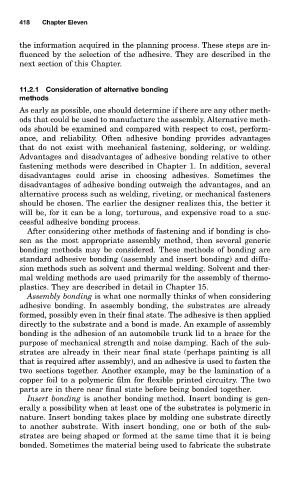Page 482 - Handbook of Adhesives and Sealants
P. 482
418 Chapter Eleven
the information acquired in the planning process. These steps are in-
fluenced by the selection of the adhesive. They are described in the
next section of this Chapter.
11.2.1 Consideration of alternative bonding
methods
As early as possible, one should determine if there are any other meth-
ods that could be used to manufacture the assembly. Alternative meth-
ods should be examined and compared with respect to cost, perform-
ance, and reliability. Often adhesive bonding provides advantages
that do not exist with mechanical fastening, soldering, or welding.
Advantages and disadvantages of adhesive bonding relative to other
fastening methods were described in Chapter 1. In addition, several
disadvantages could arise in choosing adhesives. Sometimes the
disadvantages of adhesive bonding outweigh the advantages, and an
alternative process such as welding, riveting, or mechanical fasteners
should be chosen. The earlier the designer realizes this, the better it
will be, for it can be a long, torturous, and expensive road to a suc-
cessful adhesive bonding process.
After considering other methods of fastening and if bonding is cho-
sen as the most appropriate assembly method, then several generic
bonding methods may be considered. These methods of bonding are
standard adhesive bonding (assembly and insert bonding) and diffu-
sion methods such as solvent and thermal welding. Solvent and ther-
mal welding methods are used primarily for the assembly of thermo-
plastics. They are described in detail in Chapter 15.
Assembly bonding is what one normally thinks of when considering
adhesive bonding. In assembly bonding, the substrates are already
formed, possibly even in their final state. The adhesive is then applied
directly to the substrate and a bond is made. An example of assembly
bonding is the adhesion of an automobile trunk lid to a brace for the
purpose of mechanical strength and noise damping. Each of the sub-
strates are already in their near final state (perhaps painting is all
that is required after assembly), and an adhesive is used to fasten the
two sections together. Another example, may be the lamination of a
copper foil to a polymeric film for flexible printed circuitry. The two
parts are in there near final state before being bonded together.
Insert bonding is another bonding method. Insert bonding is gen-
erally a possibility when at least one of the substrates is polymeric in
nature. Insert bonding takes place by molding one substrate directly
to another substrate. With insert bonding, one or both of the sub-
strates are being shaped or formed at the same time that it is being
bonded. Sometimes the material being used to fabricate the substrate

